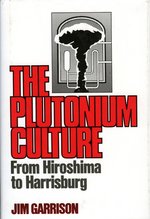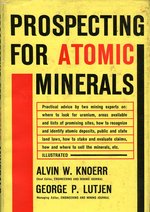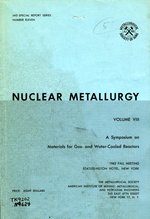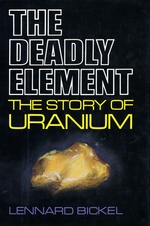From its discovery in 1789 until the early 1900s, uranium was assumed to be nothing more than an elemental curiosity. Though it became an object of scientific interest in the early twentieth century, it was not until Glenn Seaborg converted uranium-238 into plutonium that it became a major commodity. Following the successful completion of the Manhattan Project, uranium took on a new significance: it was now a matter of national security, not to mention big business. With thousands of individuals working directly with radioactive materials on a daily basis, major advances in equipment and techniques were necessary both for safety and efficiency.
The processes for extracting usable uranium-238 from the Earth were not unlike those used for other precious minerals. Uranium mining was done using a variety of techniques including open pits, underground tunnels, leaching, and occasionally borehole mining. Though strict handling and shielding procedures were created for the mining of radioelements, these were all techniques established for the extraction of non-radioactive ore. The need for new techniques arose from the enrichment process - several elements were sources of useable radiation but were difficult to properly refine..12
While pitchblende, a radioelement-rich composite material, was the traditional source for uranium, geologists began looking for alternatives in the hope of increasing production within the United States. Researchers began searching for trace and extractable quantities in shale, streams and rivers, and common mineral groups.345
As a result, in the 1950s the United States experienced a uranium boom, one fed by both government-funded and independent prospectors.6 A number of guides were published for would-be prospectors, often promising easy money for the adventurous radiation-seeker.78 Professional surveyors and geologists published their own findings, reporting possible deposits in Idaho, Montana, Wyoming and elsewhere.91011 Geologists and chemists likewise began looking at other radioactive materials like radium, polonium, and eventually tritium as potential fuel sources.121314
The mining boom had put a dollar amount on the political and military significance of nuclear materials. Radioactive materials were a desired commodity and the United States was doing its best to corner the market.
Notes
- 2148. Arkenbout, Gerardus Johannes. Separation of Lithium Isotopes by Countercurrent - exchange - electrolysis. Utrecht, 1965. Return to text ↑
- 2165. Clary, Edmund B. Atomic Energy. New York: Clary, June 1954. Return to text ↑
- 2246. Swanson, Vernon E. Oil Yield and Uranium Content of Black Shales. Washington, D.C.: USGPO, 1960. Return to text ↑
- 2259. Ward, F.N. & A.P. Marranzino. "Field Determination of Uranium in Natural Waters." Geological Survey Bulletin. pp. 181-192. Washington, D.C.: USGPO, 1957. Return to text ↑
- 2217. Larsen, Esper S., Jr. & David Gottfrid. "Distribution of Uranium in Rocks and Minerals of Mesozoic Batholiths in Western United States." Geological Survey Bulletin. pp. 63-103. Washington, D.C.: USGPO, 1961. Return to text ↑
- 2260. Weiss, Joseph L. & William R. Orlandi. You Can Find Uranium! A Non-Technical Guide, Written in Plain Understandable Language. San Francisco: J.B. Weiland, 1948. TN490.U7 W4 1948. Return to text ↑
- 2152. Ballard, Thomas J. & Quentin E. Conklin. The Uranium Prospector's Guide. New York: Harper, 1955. TN271.U7 B3. Return to text ↑
- 2249. Taylor, Raymond W. & Samuel W. Uranium Fever or No Talk Under $1 Million. New York: Macmillan, 1970. F830 .T3. Return to text ↑
- 2149. Armstrong, F.C. & P.L. Weis. "Uranium-Bearing Minerals in Placer Deposits of the Red River Valley Idaho County, Idaho." . pp. 25-36. Washington, D.C.: USGPO, 1957. Return to text ↑
- 2155. Becraft, George E. "Uranium in Carbonaceous Rocks in the Townsend and Helena Valleys Montana." Geological Survey Bulletin. pp. 145-164. Washington, D.C.: USGPO. 1958. Return to text ↑
- 2244. Stephens, James G. & M.J. Bergin. "Reconnaissance Investigation of Uranium Occurrences in the Saratoga Area Carbon County, Wyoming." Geological Survey Bulletin. pp. 321-338. Washington, D.C.: USGPO, 1959. Return to text ↑
- 2213. Kuroda, P.K. "On the Isotopic Constitution of Radium (RA-223/RA-226) in Uranium Minerals and Recent Problems of Geochronology." pp. 179-207. New York: New York Academy of Sciences, September 30, 1955. Return to text ↑
- 2221. Polonium. Ed. Moyer, Harvey. Oak Ridge: USAEC, 1956. Return to text ↑
- 2212. Krass, Allan. "The Tritium Problem: Crisis or Opportunity?" Nucleus, Volume 11, Number 1, pp. 2,5. Cambridge: Union of Concerned Scientists, Spring 1989. Return to text ↑




